- Home
- Various Articles - In Class, In the Group
- Metacognitively Speaking: Collaborate, Communicate and Connect
Metacognitively Speaking: Collaborate, Communicate and Connect
Michael Yosef lectures in content and language integrated learning and academic communication at the Center for Language Education and Research at Sophia University. He has taught philosophy for children and English for academic purposes in Japan and Singapore. His primary research interests are metacognitive engagement, L2 pedagogical acquisition and curriculum development. Email: myosef-4i4@sophia.ac.jp
Introduction
Language researchers and English foreign or second language teachers have commonly asserted that many of their learners do not ask questions, and of those who do, much lesser ask high-order questions (Humphries et al., 2020; Seiko, 2020; Soo & Goh, 2013). Many students in Singapore and Japanese high schools do not ask high-order questions during lessons in some respects (Lee, 2016; Harumi, 2011) due to a didactic instructional approach and a cluttered curriculum (Gao and Zhang, 2020) geared at preparing students for high-stakes university entrance examinations (e.g., Cambridge General Certificate of Education exams, National Center Test).
It is unsurprising that many state schools in East Asia and Southeast Asia alike have a tendency to approach language acquisition in EFL/ESL teaching, essentially, from a skills acquisition paradigm. This paradigm usually entails a considerable degree of rote learning via a series of introducing declarative knowledge and thereafter, attaining adequate proficiency in language use through repetitive practices (Lyster & Sato, 2013). A larger portion of the enacted curriculum time is attributed to grammar/vocabulary acquisition, reading comprehension, and less time is assigned to inquiry-based discussions.
When students do engage in discussions, however, many seem to falter from a lack of motivational-engagement support during the performative act. Teachers have frequently witnessed learners who are motivated, on the one hand, but disengaged. These learners are driven and do well in tests and examinations, but are generally disconnected in the learning process.
This disengagement can partly be attributed to the teaching methodology employed. Numerous hours devoted to skills acquisition, notwithstanding the best of intentions to infuse gamification into rote-teaching, may only go so far. A largely teacher-fronted didactic instructional approach of initiation, response and feedback (IRE) (Sinclair & Coulthard, 1975) in many Asian English language classrooms potentially limit learners in relation to affect. That is to say, the IRE technique does not seem to motivate nor push our learners to think critically and reflect upon their own thinking by themselves and much less simultaneously doing so with their peers. Part of the reason students do not ask the types of high-order thinking questions teachers look forward from these learners during classroom talk is because such learners may not have been taught to ask precisely, these sorts of high-order questions.
Types of Questions
A second or foreign language (EFL/ESL) teacher typically receives questions about homework or how to appropriately complete a particular assignment so as to meet expectations or fulfill assessment requirements. Questions seeking clarity are fairly common. Students, for the most part, inquire about factual or comprehension-based questions after a reading activity. In most cases, these are closed-ended questions where the teacher would supply the information students require. This pattern of questioning as noted earlier is likely due to the IRE dominant classroom discourse most learners in Asia are typically used to. Correspondingly, such learners would tend to reproduce this pattern of question-and-answer format back to their teachers when they are in doubt about a particular topic. Additionally, many students in the Japanese and Singaporean classroom contexts would frequently consult with a classmate after a lesson has ended rather than during actual class time.
Figure 1
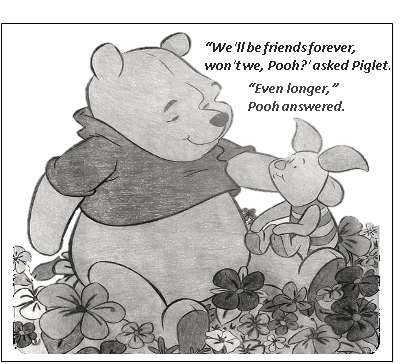
Friendship: Pooh and Piglet
Adapted from Openverse “Pooh and Piglet One”, by Rain Love AMR, n.d. (https://www.search.openverse.engineering/image/70f879f3). CC BY-NC-SA 2.0.
One way to have our learners ask the sort of questions we would like them to ask in class is to teach them a myriad type of questions that can be elicited from a printed or visual stimulus text. Stimulus texts are texts which are potentially of high-value interest to readers. These can be visual texts from the leaners` linguistic landscapes (e.g., social media, advertisements, government posters) or generic stories from students` childhood experiences such as Goldilocks and the Three Bears, Totoro My Neighbour (a popular Japanese animated fantasy film) or The Many Adventures of Winnie the Pooh. For instance, an accessible conversation based on a universal theme familiar to many learners of all ages would be friendship. The conversation between Winnie the Pooh and Piglet can be used to canvass different types of questions in the language classroom such as factual, reading comprehension, speculative and inquiry.
In the visual text example of Pooh and Piglet`s conversation in Figure 1, teachers can indicate to students the different types of questions that can be elicited from such a visual text. One way to achieve this is through the use of a Question Quadrant (Cam, 2006). The Question Quadrant is divided into four sections (see Figure 2). Reading comprehension and factual knowledge questions are questions that provide a one-off response which do not require much expansion. These are commonly known as closed questions. On the other end of the totem pole are open-ended questions where responders can provide a myriad of answers which can be further expanded. Teachers can help learners distinguish between various questions they would like their students to ask more in their classrooms—particularly, inquiry-based questions. Inquiry-based questions are generally intriguing in that they invite the reader or listener to make real-life connections with what they already know about their life-worlds and what they have yet to know about the world. There are no definitive answers. Students do not ask these sorts of questions often enough and teachers can encourage them to do so as inquiry is a habit of mind that requires adequate support and practice.
Figure 2
Eliciting Inquiry-Based Questions using the Question Quadrant
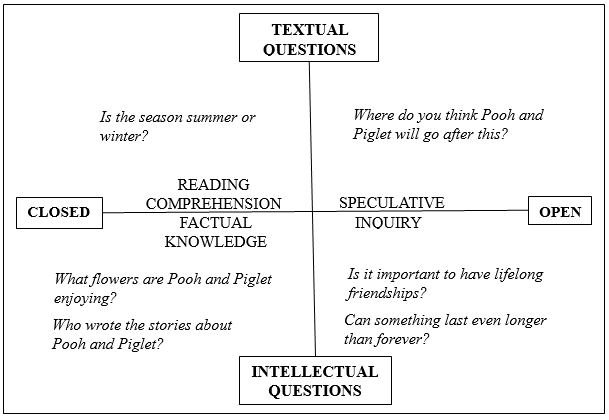
In our Pooh and Piglet example, such inquiry-based questions can look as follows: `Are lifelong friendships important?` or `Can something last even longer than forever?`. The question quadrant can be adopted in reading classrooms to, for example, adolescent students learning about expository texts. An example of one such expository text is The Broiler Chicken (O`Connor, 2021, see Appendix A) which highlights the competing industrial and ethical issues in our modern lifestyle of casual dining. The following tasks based on this text follows the cycle of activities from the Connecting Hearts and Minds flowchart in Figure 3. The first phase involves reading the text which is then followed by brainstorming and formulating possible questions about the text`s theme using the Question Quadrant.
The next phase is discussion. Here, both the class and teacher select a question for discussion. The Philosophy for Children (P4C) approach is adopted. P4C is one pedagogical approach from a family of inquiry pedagogies in language education which involves the use of calibrated probing in discussions to arrive at plausible solutions on a question of interest. The discussion builds on the notion of leaners exploring together an inquiry-based question as a community of enquirers with the teacher adopting a primarily facilitative and mediating role (see Phase 4 discussion section). In the last phase, the teacher subsequently reviews the development of the discussion and/or revisit the text for future discussions or assignments.
Figure 3
The Connecting Hearts and Minds Framework for metacognitive engagement support in discussing themes from reading texts
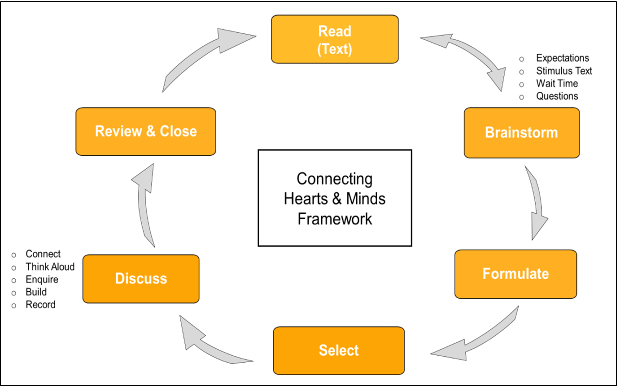
Phase 1: Reading Activity and Pre-Speaking Task
Get students to read and annotate keywords in The Broiler Chicken text. Next, ask students to identify the key themes and ideas from the text. They can highlight or underline these key content words. On a PowerPoint slide, display a trigger stimulus picture of a genetically modified chicken of a featherless chicken as shown in Figure 4. Get students to describe and share what they see as well as acknowledge their responses and feelings. Next, note to the students the chicken`s genes have been modified so that it can be efficiently processed at a lower cost for human consumption.
Figure 4
The Featherless Chicken


From Openverse "Featherless Chicken", by bbum, n.d. (https://wordpress.org/openverse/image/f7aed4ec). CC BY-NC-ND 2.0.
Phase 2: Brainstorm and Formulation
Put students in groups of four and give each group a question quadrant handout. Get students to brainstorm and fill out the four quadrants with as many questions as they can. On the class board, draw a quadrant and ask students the various factual, reading comprehension, imaginative and speculative questions they came up with as a group. Write these questions on the board.
Phase 3: Selection and Setting Expectations
Focus on the last inquiry quadrant. Poll the class which inquiry questions from the list they would like to discuss. Next, establish expectations with the class as a community prior to their group discussion on the chosen inquiry question.
As teachers will not be imposing expectations, the P4C approach requires teachers to practice releasing some control to enable greater responsibility and trust to develop in their learners. Learners are engaging in a social practice as a community of enquirers who are tasked to explore an interesting inquiry-based question that is meaningful and accessible. In establishing these rules of engagement, technology can be pedagogically effective here to create the initial setup of such a community. AnswerGarden is one such online app that can be used for creative brainstorming that allows for a certain degree of anonymity (Figure 5). Learners can be asked what sort of rules they would like to have during the discussion. Here, teachers can role-model the value of open communication, respect, intellectual humility and fairness by facilitating this pre-discussion activity. The class needs to agree on the rules they would want to practice as a community, and how best to respond should the discussion rules are broken.
Figure 5
Second year Japanese EFL college students` establishing rules of engagement as a community on AnswerGarden
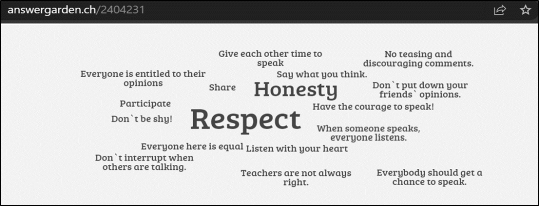
Some questions which past classes had come up with are grouped and listed in Figure 6 below. These are classified into the four question types based on the Question Quadrant.
Figure 6
Questions on The Featherless Chicken from 8 graders in one mid-tier Singaporean public high school P4C session using the Connecting Hearts and Minds Framework
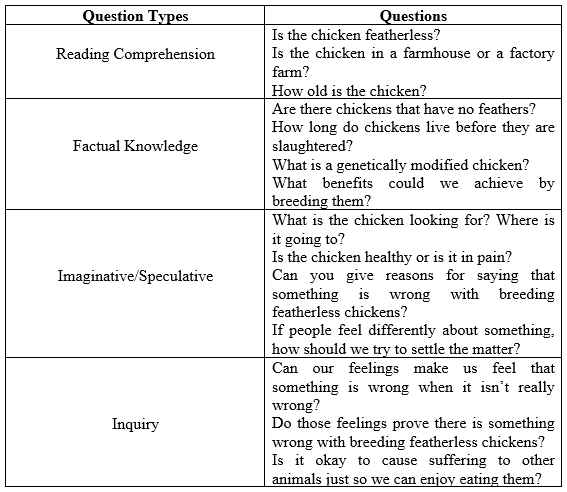
Phase 4: Discussion
Below are two suggested speaking activity setups that were used for large classes as well as smaller classes for the discussion in Phase 4 that educators and language instructors can adopt.
Speaking Activity (small classes)
In small classes, the teacher can facilitate a discussion on the inquiry question by sitting in a circle with learners. The teacher serves as an active listener and builds upon the views expressed by his/her students, expanding and making connections with what was said by other students in the group and moving the inquiry forward by inviting other students to respond to the current view that is in conversation. The teacher verbally thinks aloud while thoughtfully probing the given responses to draw out particular perspectives or positions. This interpersonal dialogic engagement in this small community occurs as the teacher adopts a facilitating role and speaks lesser than the students but probes more in order to allow students to reflect on the thoughts of their peers (see Excerpts 1.1 & 1.2). This allows active participation among learners in the dialogic exchange as many students are naturally motivated to know what their peers think. This peer interrelations of thoughts within a community of enquirers when mediated at an appropriate pace serves as a motivational-engagement support for the inquiry process to develop.
In classes with high progress learners, a student can be chosen to be a scribe. He or she would paraphrase the points that are raised during the discussion on a flipchart. This would keep the group focused on the salient thematic development during the exchange.
Speaking Activity (large classes)
In larger EFL/ESL classrooms (e.g., 35 to 50 students), it is more effective to have learners first discuss their views in small groups before moving on to a teacher-class wide discussion (Yosef, 2016). Students are given 20 minutes to discuss their views and opinions on the class-selected inquiry question which received the highest vote count. During the ensuing teacher-class wide discussion, various responses can eventually be solicited from the various members of these small groups.
Thinking Moves for Probing an Inquiry Topic
To facilitate an effective inquiry on the chosen topic for discussion, it is essential for instructors to know several thinking moves in managing P4C discussions. Some of these questioning moves can be observed in the classroom discourse language in the extracts below, where students engage in a dialogic exchange on an inquiry topic. Extracts 1.1 and 1.2 highlight a section of a dialogic exchange between a classroom teacher and her six students (3 male and 3 female) from a class of 30 students. These extracts focus on significant interactional moves adopted by the teacher as best practices. A conversation analytic approach was used to analyse the classroom discourse transcripts. Participants were grade 8 ESL learners who inhabited a wide L2 proficiency spectrum from a mid-tier Singaporean public high school. The participants (all names are pseudonyms) were seated in a circle and were engaged as a community of enquirers on the topic: `Do the reasons against breeding featherless chickens outweighs the benefits?`.
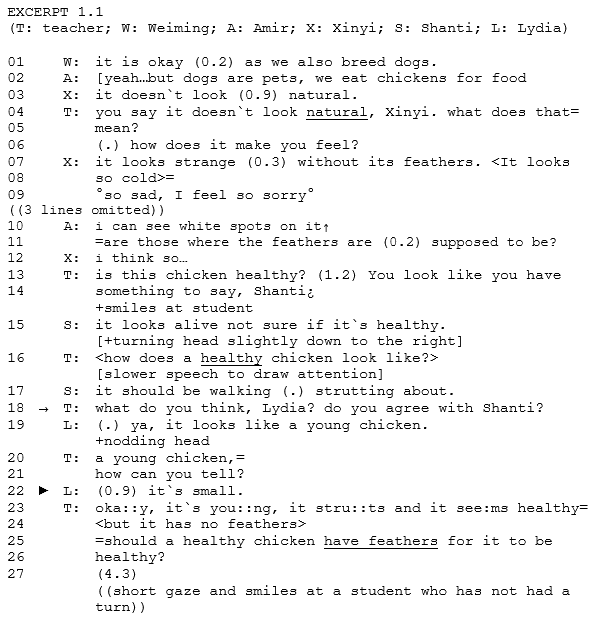
In Excerpt 1.1, several interactional moves can be observed of how the teacher facilitates the discussion. In line 03, she emphasized on a content word, natural, and reformulated the word with a direct prompt to elicit answers. By paying attention to the emphatic response the student had about the featherless chicken picture, more specificity from the production was obtained. In another instance, the teacher adjusted the speed of her speech to draw attention to another content word, healthy. In line 13, the teacher acknowledged a student`s pondering gestures to elicit thoughts. The teacher registered her recognition of this thinking act on the part of her student by extending a smile. This non-verbal gesture legitimizes for the student the teacher`s non-judgmental mode of questioning which potentially reduces language anxiety for the reticent participant who may be concern about groupism, i.e., privileging a group`s opinion over one`s own. Thereafter, the teacher-facilitator followed with a turn exchange with another participant, Lydia, in the circle for a response. Clarification was sought with the question, “how can you tell?” in line 21. By repeating the phrase, “a young chicken,” the teacher enables other students in the circle to track the development of the discussion. Another questioning strategy observed to facilitate response development is the use of the “how” question, i.e., “how can you tell?”.
Noticing the short silence before Lydia offered her brief reply, the teacher reduced her speaking speed thereafter by lengthening her vowels in “oka::y, it`s you::ng, it stru::ts and it see:ms healthy” in line 23 and slowing her speech, “<but it has no feathers>”. This simple reviewing act prepares the group for a follow-up question, “should a healthy chicken have feathers for it to be healthy?” Here, the teacher recasted the question and stressed on a functional word and a salient content word, “have feathers” in line 25, redirecting the group to probe the question it has arrived at during the inquiry process as a community. Wait time was given when a higher order question was next formulated to advance interaction. The teacher opens the question with a smile which seems to indicate this non-verbal gesture is a fundamental interactional resource to enhance self-initiation within the group.
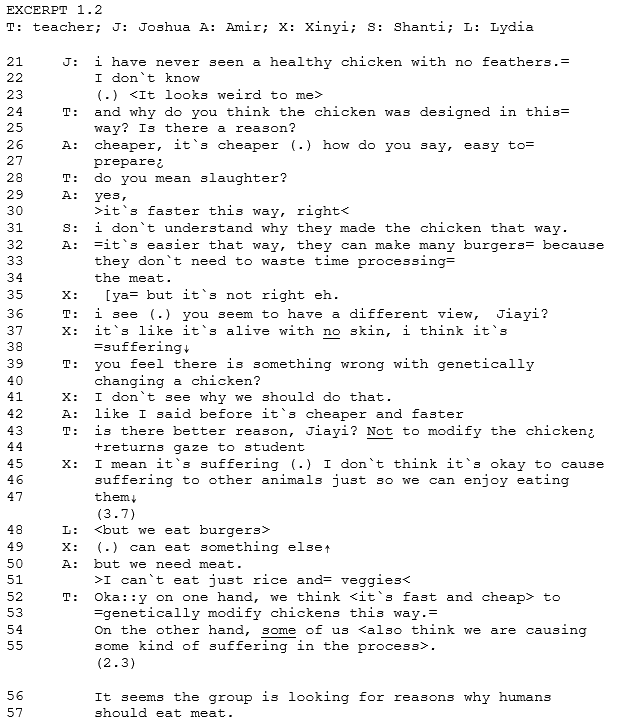
In extract 1.2, we see further scaffolding techniques in the form of questioning moves adopted by the teacher to further the discourse. At lines 24 and 25, she requested support for the student`s opinion by seeking for more general abstract responses instead of personal responses. As another student chimed in, the teacher did not stop the interjection, in line 26, and instead recasted the student`s answer with a content word. This potentially has a decentralizing effect on the discourse in that it allows the students to engage in peer-to-peer interrelations as a community of enquirers, as opposed to sustaining a teacher-fronted dyadic discourse, where an interview question-and-answer interaction dominates.
At line 35, X remarks overlaps with A, to which the teacher formulated a clarification request (i see (.) you seem to have a different view, Jiayi?). X responded with an emphasis on the word “no” in line 37 to substantiate her view. Noticing the sympathetic response, the teacher elicits the position underlying the emotion in her pragmatic turn (something wrong, line 39) and reformulated the L2 output (genetically changing a chicken). Here, the teacher had introduced a more academic word choice. As the group delves further into the communicative act, the teacher used a subsequent elicitation strategy with a direct prompt in line 43 to elicit further substantiation by lightly stressing on the adverb, “Not”. The teacher curiosity was observed in her slightly rising intonation and her refrain from making repairs to syntactical structures (line 49, can eat something else). Following X`s emphatic response, the group enters into silence. Thereafter, more spontaneous production ensues among the students indicating some cognitive dissonance had arisen in the prior interaction. The teacher subsequently synthesized the development of the discussion using slower speech for added clarity and posed a follow-up question that places a higher cognitive demand for an ensuing discussion.
Phase 5: Close and Review
In this phase, the teacher closes the discussion with a brief review of the progress the group has made. The use of visual flowcharts or the discussion notes scribed earlier on the class flipchart can be a very effective reflective tool for learners to visualize the development of the discussion that transpired. The outcome of a discussion is determined by how far the group is able to progress as a community. In this respect, the Connecting Hearts and Minds framework emphasizes on the values of inquiry as a process rather than solely a product-based outcome of learning. Notwithstanding the process-based approach proffered here, for curriculums which adopt product-based outcomes of learning, teachers can issue a post-discussion task, such as a writing task where students write their reflections on the theme discussed earlier in a journal entry or on an online blog. Additionally, depending on the proficiency level of learners, they may be assigned a discursive or argumentative essay as a post-discussion assignment.
Conclusion
In an increasingly digitalized and atomized world, supporting metacognitive engagement in learners is increasingly important. The era of the knowledge-based economy has brought with it curricular challenges which require educators to engage their learners in literacy as well as metacognitive literacy. The motivational-engagement support in the form of question quadrants and thinking moves for inquiry-based discussions adopted in this article is one of several approaches to enhance the design of learning experiences by connecting the hearts and minds of our learners.
References
Cam, P. (2006). Twenty thinking tools: Collaborative inquiry for the classroom. ACER Press.
Harumi, S. (2011). Classroom silence: Voices from Japanese EFL learners. ELT journal, 65(3), 260-269. https://doi.org/10.1093/elt/ccq046
Humphries, S., Akamatsu, N., Tanaka, T. & Burns, A. (2020). 7. Silence in Japanese Classrooms: Activities and Factors in Capacities to Speak English. In J. King & S. Harumi (Ed.), East Asian Perspectives on Silence in English Language Education (pp. 123-142). Bristol, Blue Ridge Summit: Multilingual Matters. https://doi.org/10.21832/9781788926775-012]
Lee, R. (2016). Implementing dialogic teaching in a Singapore English language
classroom. RELC Journal, 47(3), 279–293. https://doi.org/10.1177/0033688216631171
Lyster, R., & Sato, M. (2013). Skill acquisition theory and the role of practice in L2 development. In M. García Mayo, J. Gutierrez-Mangado, & M. Martínez Adrián (Eds.), Contemporary approaches to second language acquisition (pp. 71–91). Amsterdam, Netherlands: John Benjamins.
O`Connor, K. (2021, March). The genetically modified chicken: How we have altered ‘Broiler’ chickens for profit. One Green Planet. https://onegreenplanet.org/animalsandnature/the-genetically-modified-chicken-how-we-have-altered-broiler-chickens-for-profit
Sinclair, J. & Coulthard, M. (1975). Towards an Analysis of Discourse. Oxford University Press.
Soo, R. S., & Goh, H. S. (2013). Reticent students in the ESL classrooms. Advances in Language and Literary studies, 4(2), 65-73.
Yosef, M. (2016). Impact of philosophy for children embedded in a metacognitive teaching framework: Students’ perception and achievement on reading comprehension. National Institute of Education. https://hdl.handle.net/10497/18595
Appendix A
The Genetically Modified Chicken: How We Have Altered `Broiler` Chickens for Profit
Retrieved from http://www.onegreenplanet.org/animalsandnature/the-genetically-modified-chicken-how-we-have-altered-broiler-chickens-for-profit/
Dr. Frankenstein is alive and well, and he is running our food system. There has been quite a bit of buzz lately about GMOs (Genetically Modified Organisms), especially corn and soy. But what many people don’t realize is that the agriculture industry has also been genetically modifying farmed animals for years. The results of decades of selective breeding are even more shocking and strange than pesticide-resistant corn or apples that never turn brown. One good example of the bizarre outcome of these cruel experiments is the modern chicken.
The chicken is no longer just a chicken. Depending on what they are bred for, modern chickens are either “layers” or “broilers.” Bred, of course, to lay eggs, layers have been so dramatically altered that they can lay more than 250 eggs per year, while their ancestors in the jungle laid about two dozen annually. They do not grow fast enough to be used for meat, however, which is why all of the non-egg-producing males of the layer breeds are killed soon after hatching. This is where the “broilers” come in.
Genetically Modified Chickens
Today’s broiler chickens have been bred selectively since the 1950s to produce meat—breast meat in particular—and to produce it quickly. A modern meat chicken weighs up to three kilograms: almost double the size of a chicken from 60 years ago. And their breasts are 80 percent larger. They also manage to reach this size in six weeks, whereas it took a bird in the 50s up to 15 weeks to reach its fully grown (but much smaller) size. Not surprisingly, this accelerated growth leads to health problems and suffering for the animals.
The rapid growth rate of broiler chickens makes simply moving from one place to another a difficult and painful task. A 2008 study of more than 50,000 chickens found that by the age of 40 days, over 27 percent of the birds had impaired locomotion capabilities and 3.3 percent were almost unable to walk. This large percentage of lame birds becomes even more disturbing when we consider that chickens whom the farmers considered lame had already been culled due to welfare policies.
These disabilities largely stem from the imbalance in the birds’ bodies; due to excessively large breasts, they are “front heavy,” which adds to the strain on their legs. Other factors caused by rapid growth—including micro fractures and degenerative bone disease — also contribute to this lameness. Another study found that if lame birds received painkillers in their feed, they would become more mobile. In fact, lame birds actually chose analgesic-laced food over normal food, which non-lame birds did not do. This leads to the inevitable conclusion that a large percentage of “meat” chickens are in pain for at least a portion of their lives.
Suffering for Profit
Lameness is just one of many health issues broilers often face. Others include cardiopulmonary problems and sudden death syndrome. Even the birds kept alive for breeding purposes — whom some might consider lucky — endure their own kind of suffering due to their design for rapid weight gain. When allowed to grow to full size, broiler “breeders” experience fertility problems so their food intake is typically restricted to keep them underweight. In fact, they may be given less than half the amount of food that other birds receive. It is reasonable to suspect that they live their lives in a perpetual state of hunger.
Perhaps more than any other animal, the modern broiler chicken is a victim of our growing appetite for cheap meat — as well as animal agriculture’s rapid industrialization over the past half-century. The more than eight billion birds raised and killed in the United States every year serve as examples of what can happen when the cruel calculus of efficiency and profit is applied to living creatures. As in the classic tale, it turns out that the real monster is Dr. Frankenstein himself.
Appendix B
Transcript notations
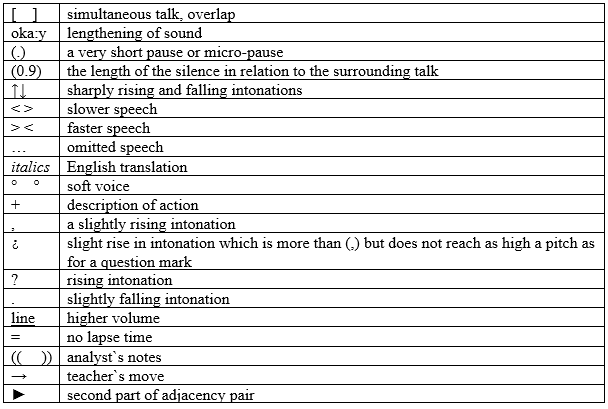
Please check the Pilgrims f2f courses at Pilgrims website.
Please check the Pilgrims online courses at Pilgrims websit
Metacognitively Speaking: Collaborate, Communicate and Connect
Michael Yosef, JapanPeer Feedback in Formative Learning
Valentina Batagelj, Slovenia